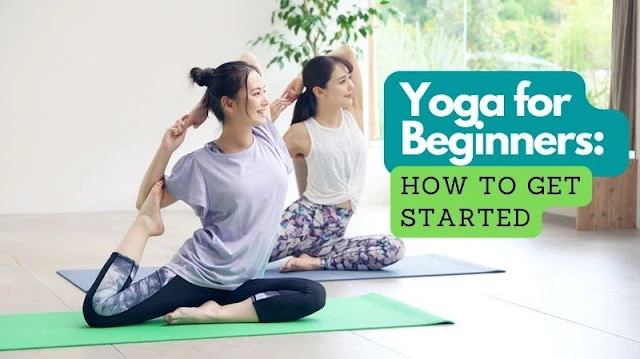If you’re reading this, chances are you’re interested in yoga for beginners. Whether you’re looking to increase your flexibility, reduce stress, or just try something new, yoga is a great way to improve your physical and mental well-being.
What is Yoga? Yoga is an ancient practice that originated in India and has been around for thousands of years. It involves a combination of physical postures (asanas), breathing techniques (pranayama), and meditation to improve overall health and well-being.
There are numerous benefits to practicing yoga, especially for beginners. Yoga has been shown to have many benefits for the mind and the body. It can help improve flexibility, strength, balance, and overall fitness. Yoga is a great way to reduce stress and anxiety, improve sleep, and increase focus and concentration. It’s a practice that can be enjoyed by people of all ages and fitness levels, making it the perfect starting point for a beginner. See also: The benefits of yoga.
Are you ready to start your yoga journey? Please keep reading to learn more about getting started with yoga and making it a consistent part of your life. Remember, yoga is a practice that takes time and patience, but with dedication and consistency, you’ll soon be reaping the many benefits of this ancient practice.
Understanding the Basics of Yoga
Different types of yoga
When understanding the basics of yoga, it’s essential to know the available types. Each type of yoga has its unique focus, and some may be more suitable for beginners than others. In this section, we’ll discuss three popular types of yoga: Hatha, Vinyasa, and Kundalini.
1. Hatha Yoga
Hatha Yoga is one of the most popular types of yoga for beginners. It’s a gentle form of yoga that focuses on proper alignment and breathing. Hatha classes typically involve a series of slow, static poses and are a great way to build strength, flexibility, and balance.
2. Vinyasa Yoga
Vinyasa Yoga, also known as “flow” yoga, is a more dynamic form focusing on movement and breath. Vinyasa classes involve a series of poses linked together in a flowing sequence. This type of yoga is a great way to build cardiovascular fitness and increase flexibility and balance.
3. Kundalini Yoga
Kundalini Yoga is a form of yoga that focuses on awakening the body’s energy, also called “Kundalini energy,” and it’s a more spiritual and meditative form of yoga. Kundalini classes involve a combination of movement, breathwork, and meditation. This type of yoga is excellent for beginners looking to connect with their inner selves and develop a deeper understanding of their spiritual practices.
It’s essential to keep in mind that these are just a few examples of the many types of yoga available. Each type of yoga has its unique focus, and the one that’s right for you will depend on your personal preferences and goals. Try out different types and styles of yoga to find which one resonates with you and your body the most.
Importance of proper alignment and breath
Proper alignment and breath are two essential elements of yoga practice. Understanding the importance of these elements and how to execute them properly will help you get the most out of your practice and avoid injury.
What is alignment, and why is it important?
Alignment refers to the proper positioning of the body during yoga poses. It’s important because it helps ensure that you perform the pose correctly and get the most benefit. Proper alignment also helps prevent injury by placing the body in a safe and stable position. To achieve proper alignment in a pose, pay attention to the alignment of your joints and the placement of your body in relation to gravity.
How to breathe correctly in yoga
Breathing is another important aspect of yoga practice. In yoga, we often use specific breathing techniques called “pranayama.” Proper breathing can help improve focus and concentration, reduce stress and anxiety, and increase oxygen flow to the body.
The most common breathing technique in yoga is called “Ujjayi,” breathing, a slow and controlled breath through the nose. This type of breathing is done by partially closing the back of the throat, which creates a subtle sound.
Finding the Right Yoga Class
How to choose a class that is right for you
Now that you have a basic understanding of yoga and its available types, it’s time to find a suitable yoga class. Choosing the right class can be overwhelming, especially if you’re new to yoga, but don’t worry, and we’ve got you covered.
What to look for in a beginner’s yoga class
When looking for a beginner’s yoga class, it’s essential to consider the type of yoga being taught, the teacher’s qualifications, and the class size. A beginner’s class should focus on proper alignment and breathing, and the teacher should be able to modify poses to accommodate different levels of fitness. Additionally, small class size will allow the teacher to give more individual attention to each student.
Tips for finding a class that fits your schedule
Another thing to consider when choosing a class is how it fits into your schedule. Many studios and gyms offer a variety of class times, so you can find one that works for you. If you cannot make it to a studio or gym, you can take plenty of online yoga classes from the comfort of your home.
How to prepare for your first class
What to wear to a yoga class
Once you’ve found a suitable class, you must be prepared for your first class. What to wear to a yoga class is simple, comfortable clothing that allows you to move freely and doesn’t restrict your breath. You should also avoid wearing jewelry or anything that might get in the way of your practice.
What to bring to a yoga class
Consider bringing a yoga mat, towel, and water bottle to class. If you still need to get your mat, most studios and gyms provide mats for students. And remember to arrive a few minutes early to your first class to introduce yourself to the teacher and let them know that it’s your first class, in case they have any recommendations for you.
In conclusion, finding a suitable yoga class is key to enjoying your practice. Choosing a class that is suitable for beginners, taught by a qualified teacher, and fits into your schedule is essential. By being prepared, you can ensure that your first yoga class is a positive and enjoyable experience. Remember, the most important thing is that you feel comfortable, safe, and excited to start your yoga journey.
Building a Home Practice
Tips for setting up a home yoga practice
While attending yoga classes at a studio or gym can be a great way to start yoga, it’s only sometimes possible to make it to a class. That’s why building a home yoga practice can be a great alternative. With a home practice, you can practice yoga whenever it’s convenient for you, and you don’t have to worry about fitting it into your schedule.
Create a designated space for yoga.
Creating a designated space for yoga is essential when setting up a home yoga practice. It can be a corner of a room, a spare room, or even a mat placed in a quiet area of your home. Most importantly, the space is quiet, comfortable, and free from distractions.
Create a schedule for your home practice.
Another critical aspect of building a home practice is creating a schedule. It can be as simple as setting aside 10-15 minutes daily for your practice. You can also be more specific and plan your practice for the week. It’s essential to find a schedule that works for you and stick to it as much as possible.
Recommended yoga poses and sequences for beginners
Now that you have your space and schedule ready, it’s time to start practicing. Here are two recommended yoga sequences for beginners:
1. Beginner’s Sun Salutation:
- Mountain Pose
- Forward Fold
- Halfway Lift
- Plank Pose
- Cobra Pose
- Downward Facing Dog
2. Beginner’s Standing Sequence:
- Mountain Pose
- Standing Forward Bend
- Halfway Lift
- Warrior I
- Warrior II
- Triangle Pose
- Child’s Pose
These sequences are just a starting point, and many other poses and sequences are suitable for beginners. Remember to breathe deeply, move slowly, and always listen to your body. Remember, the most important thing is that you enjoy your practice, and you can always modify or skip any pose that doesn’t feel comfortable for you.
Staying Motivated and Consistent
Tips for staying motivated in your yoga practice
Starting a yoga practice is easy, but staying motivated and consistent can be challenging. That’s why it’s essential to set realistic goals for your practice and find ways to track your progress.
1. Set realistic goals for your practice
When setting goals for your yoga practice, it’s essential to keep them practical and specific. For example, instead of “doing more yoga,” set a clear goal of practicing yoga for 20 minutes every day for the next week. As you achieve your goals, you can gradually increase the frequency and duration of your practice.
2. Track your progress.
Tracking your progress is another great way to stay motivated. You can use a journal or app to record your practice and make a note of any improvements or challenges. It will not only help you stay accountable but also helps you to see your progress. You can also track other aspects of your health, such as sleep quality, stress levels, and overall well-being, to see how your yoga practice impacts your overall health.
Another way to stay motivated is to mix up your practice. Make sure to stick to the same routine every day. Try different styles of yoga, or add in new poses and sequences. It will keep your practice interesting and make it more varied. You can also try practicing at different times of the day or in other locations to keep your practice fresh.
Finally, remember that consistency is critical. It’s easy to get discouraged if you miss a day or two of practice, but the most important thing is to keep returning to your practice. Even if you can only practice for a few minutes, that’s still better than nothing. And remember, missing a day, or two of practice is okay. Just keep that from turning into a week or more.
How to make yoga a consistent part of your life
Making yoga a consistent part of your life is essential to reap its many benefits. But with busy lives and many responsibilities, it can take time to find the time and make it a regular practice. However, with some planning, you can easily incorporate yoga into your daily routine and make time for it even when life gets busy.
1. Incorporate yoga into your daily routine
One of the best ways to make yoga a consistent part of your life is to incorporate it into your daily routine. It can be as simple as setting aside 10-15 minutes every morning for quick practice. It can also add a yoga session to your lunch break or before bed. Making yoga a part of your daily routine will become a habit you don’t even have to think about.
2. Make time for yoga when life gets busy.
Another way to make time for yoga when life gets busy is to prioritize it. Like you would schedule a meeting or an appointment, schedule your yoga practice into your calendar. It will help you to remember to practice, and it will also make it harder to cancel.
You can also try different forms of yoga that can do in shorter amounts of time, such as Yoga Nidra, a guided relaxation technique, or Surya Namaskar, a series of 12 poses that can do in a short amount of time.
Conclusion
As a beginner, it’s important to remember that yoga is a journey, not a destination. Developing a consistent practice takes time and patience, and progress may take time and effort. Still, with dedication and consistency, you’ll soon be reaping the many benefits of this ancient practice.
In conclusion, yoga is a holistic approach to wellness that can benefit beginners in many ways. We hope this guide has provided you with the information and inspiration you need to start your own yoga practice. Remember to take it one step at a time, be patient, and enjoy the journey. Namaste!












